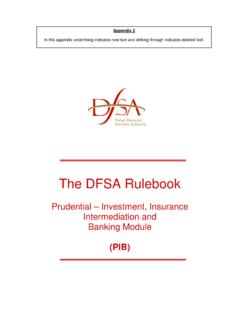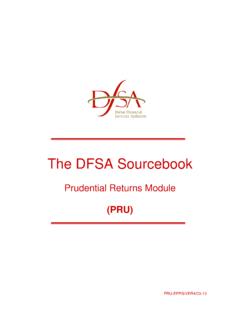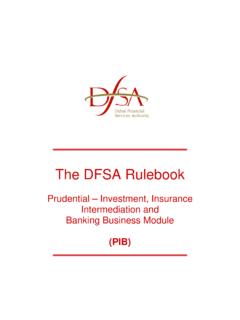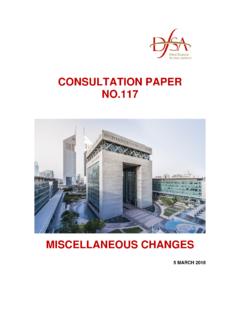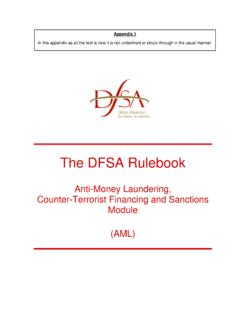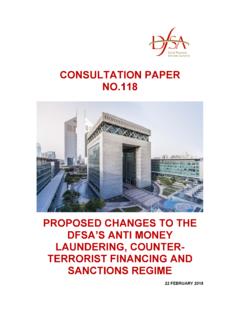Transcription of The DFSA Rulebook
1 PIB/VER31/04-18 The DFSA Rulebook Prudential Investment, Insurance Intermediation and Banking Module (PIB) PRUDENTIAL INVESTMENT, INSURANCE INTERMEDIATION AND BANKING (PIB) I PIB/VER31/04-18 Contents The contents of this module are divided into the following chapters, sections and appendices: 1 APPLICATION, INTERPRETATION AND CATEGORISATION ..1 Application .. 1 Glossary for PIB .. 5 Categories of Authorised Firms .. 18 Systemically Important Banks (SIBs) .. 21 2 GENERAL REQUIREMENTS .. 24 Introduction .. 24 Application .. 24 Trading Book .. 24 Reporting to the DFSA .. 25 Prudent valuation practices .. 26 3 CAPITAL .. 27 Introduction .. 27 PART 1 Application .. 27 Application .. 27 PART 2 Basic Requirements .. 28 Requirements .. 28 PART 3 Calculating the Capital Requirement .. 32 Capital Requirements for Categories 1 and 5 .. 32 Capital Requirements for Categories 2 and 3A.
2 32 Capital Requirements for Categories 3B, 3C and 4 .. 33 Base Capital Requirement .. 34 Expenditure Based Capital Minimum .. 34 Risk Capital Requirement .. 36 Capital Conservation Buffer .. 37 Countercyclical Capital Buffer (CCyB) .. 38 HLA Capital Buffer .. 41 Failure to meet a Capital Buffer Requirement .. 43 PART 4 Calculating Capital Resources .. 47 Application .. 47 Calculation of Capital Resources .. 47 Tier 1 capital (T1 Capital) .. 48 Common Equity Tier 1 capital (CET1 Capital) .. 48 Additional Tier 1 capital (AT1 Capital) .. 57 Tier 2 capital (T2 Capital) .. 62 Minority interests and instruments issued by Subsidiaries .. 66 Qualifying Holdings outside the financial sector .. 69 PRUDENTIAL INVESTMENT, INSURANCE INTERMEDIATION AND BANKING (PIB) II PIB/VER31/04-18 PART 5 Calculating the Leverage Ratio .. 71 Leverage Ratios .. 71 4 CREDIT RISK.
3 73 Introduction .. 73 PART 1 Application .. 73 Application .. 73 PART 2 Credit Risk systems and controls .. 75 Application of this part .. 75 Credit Risk management systems .. 75 Credit Risk strategy, policy, and procedures manual .. 78 Processes for credit assessment .. 82 PART 3 - CRCOM .. 86 Application .. 86 Simplified Approach .. 86 Calculation of the CRCOM .. 87 Methodology for measurement of Exposures .. 89 Categorisation of Credit Risk Exposures (CR Exposures) .. 94 Credit Quality Grade and External Credit Assessments .. 96 Risk weights .. 97 Credit Risk mitigation .. 103 Securitisation .. 115 Concentration Risk .. 133 5 MARKET RISK .. 139 Introduction .. 139 Application .. 139 Market Risk systems and controls .. 140 Calculation of the Market Risk Capital Requirement .. 140 Interest Rate Risk Capital Requirement .. 141 Equity Risk Capital Requirement.
4 141 Foreign Exchange Risk Capital Requirement .. 141 Commodities Risk Capital Requirement .. 142 Option Risk Capital Requirement .. 142 Collective Investment Fund Risk Capital Requirement .. 142 Securities Underwriting Capital Requirement .. 142 Use of internal Market Risk models .. 144 6 OPERATIONAL RISK .. 146 Introduction .. 146 Application .. 146 Risk management framework and governance .. 147 Risk identification and assessment .. 149 Risk monitoring and reporting .. 151 PRUDENTIAL INVESTMENT, INSURANCE INTERMEDIATION AND BANKING (PIB) III PIB/VER31/04-18 Control and mitigation .. 152 Information Technology (IT) systems .. 152 Information security .. 153 153 Business continuity and disaster recovery .. 154 Management of Operational Risks in trading activities .. 154 Operational Risk Capital Requirement .. 156 Professional indemnity insurance .. 157 7 INTEREST RATE RISK IN THE NON-TRADING BOOK.
5 159 Introduction .. 159 Application .. 159 Stress testing for Non-Trading Book interest rate risk .. 159 Non-Trading Book interest rate risk under chapter 10 .. 160 Systems and controls for Non-Trading Book interest rate risk .. 161 8 GROUP RISK .. 166 Introduction .. 166 Application .. 166 Systems and controls requirements .. 167 Financial Group Capital Requirements and Financial Group Capital Resources 168 Financial Group Concentration Risk limits .. 170 Restrictions on ownership or control .. 170 9 LIQUIDITY RISK .. 172 Introduction .. 172 Application .. 172 Liquidity Risk policy, systems and controls .. 172 Funding strategy, stress testing and contingency funding plan .. 181 Liquidity requirements .. 187 10 SUPERVISORY REVIEW AND EVALUATION PROCESSES .. 194 Introduction .. 194 Application .. 194 Overview .. 194 IRAP .. 195 ICAAP .. 196 SREP .. 197 Imposition of an Individual Capital Requirement.
6 197 11 DISCLOSURE REQUIREMENTS .. 199 Introduction .. 199 Application and general obligation of disclosure .. 199 PRUDENTIAL INVESTMENT, INSURANCE INTERMEDIATION AND BANKING (PIB) IV PIB/VER31/04-18 Disclosure policy .. 200 Disclosure frequency, locations and process .. 200 APP1 CATEGORIES OF AUTHORISED FIRMS .. 202 Categorisation of Authorised Firms .. 202 APP2 GENERAL REQUIREMENTS .. 204 Detail in the Trading Book .. 204 Trading Book policy .. 210 Risk management systems and controls for Trading Book .. 212 Reporting to the DFSA .. 212 Prudent Valuation Practices .. 220 APP3 CAPITAL .. 223 Stress and scenario testing .. 223 APP4 CREDIT RISK .. 225 Credit Risk systems and controls .. 225 Credit conversion factors (CCFs) for calculating Exposures .. 235 Collateral calculations and haircuts .. 237 Qualifying securities financing transactions (SFTs) .. 247 Requirements for use of VaR models.
7 247 Credit RWA - Unsettled Transactions, free deliveries and OTC Derivatives .. 248 Credit RWA - repurchase agreements, reverse repurchase agreements, similar transactions and other deferred settlements .. 253 Credit RWA - other Trading Book transactions .. 255 Exposures to Central Counterparties (CCPs) .. 255 Securitisation .. 256 Concentration Risk .. 260 The Simplified Approach for Category 2 and 3A firms .. 268 APP5 MARKET RISK .. 271 Market Risk systems and controls .. 271 Interest Rate Risk Capital Requirement .. 273 Equity Risk Capital Requirement .. 286 Foreign Exchange Risk Capital Requirement .. 291 Commodities Risk Capital Requirement .. 293 Option Risk Capital Requirement .. 297 Collective Investment Fund Risk Capital Requirement .. 301 Securities Underwriting Risk Capital Requirement .. 303 Use of internal models for Market Risk .. 309 APP6 CALCULATING THE OPERATIONAL RISK CAPITAL REQUIREMENT.
8 320 Basic Indicator Approach .. 321 Standardised Approach .. 322 Alternative Standardised Approach .. 324 PRUDENTIAL INVESTMENT, INSURANCE INTERMEDIATION AND BANKING (PIB) V PIB/VER31/04-18 APP7 NOT USED .. 327 APP8 NOT USED .. 328 APP9 LIQUIDITY .. 329 Application for a global liquidity concession .. 329 The Liquidity Coverage Ratio .. 330 The Maturity Mismatch approach .. 346 The Net Stable Funding Ratio (NSFR) .. 348 APP10 SUPERVISORY REVIEW AND Evaluation PROCESSES .. 356 IRAP .. 356 ICAAP .. 357 Supervisory Review and Evaluation Process (SREP) .. 359 APP11 PUBLIC DISCLOSURE 362 PRUDENTIAL INVESTMENT, INSURANCE INTERMEDIATION AND BANKING (PIB) 1 PIB/VER31/04-18 1 APPLICATION, INTERPRETATION AND CATEGORISATION Application (1) This module (PIB) applies to every Authorised Firm other than: (a) an Insurer; (b) a Representative Office; and (c) a Credit Rating Agency.
9 (2) The Rules in PIB apply to an Authorised Firm in accordance with its Category determined under section (3) Where a chapter, part or section of PIB applies to a limited scope of Categories of Authorised Firm, the term Authorised Firm used in those provisions is to be read accordingly. (4) The Rules in PIB apply to the whole business of an Authorised Firm except in relation to Client Assets and Insurance Money that are held or controlled by an Authorised Firm which are not included in any prudential calculation. Branches Unless otherwise directed by the DFSA, an Authorised Firm that is a Branch is required to comply with the Rules in chapters 2 to 11 as specifically provided in Application Table A which forms part of this Rule. Guidance 1. The effect of Rule (1) is that these Rules apply to all Authorised Firms, except those carrying on Insurance Business (that is, Insurers), that operate a Representative Office and those that are CRAs.
10 Those Authorised Firms that are authorised to effect or carry out Contracts of Insurance should refer to the PIN module. Authorised Firms that are authorised to Operate a Representative Office should refer to the REP module. 2. These Rules apply both to Domestic Firms and, to the extent specified in Rule , to Authorised Firms conducting Financial Services through a Branch in the DIFC. 3. The Rules in PIB reinforce the fitness and propriety requirements found in GEN chapter 5 - Management Systems and Principle 4 for Authorised Firms. The PIB module is set out in: a. an initial chapter establishing a categorisation of firms for the application of PIB; b. two general chapters setting overall requirements: General Requirements and Capital; c. six chapters setting specific requirements relating to the following particular risks or issues: Credit Risk, Market Risk, Operational Risk, Interest Rate Risk in the Non-Trading Book, Group Risk and Liquidity Risk; d.



